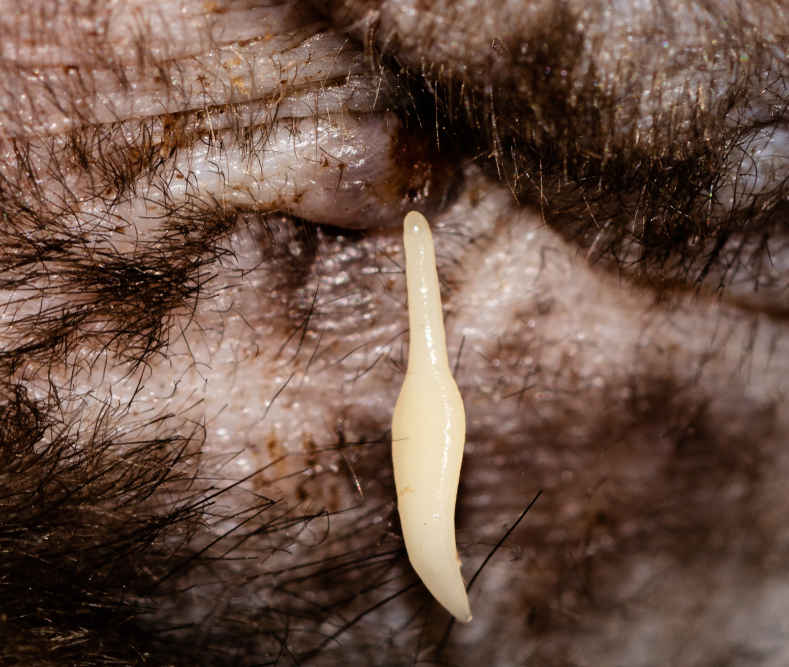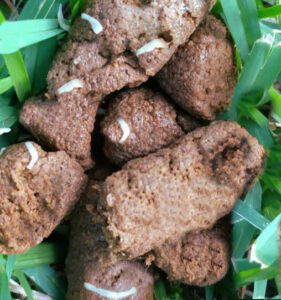
Sometimes, a client would come to my veterinary clinic because it looked like their puppy had something that looked like grains of rice sticking around their bottom. The owners usually noticed the whiteish pieces after their pooch started scooting or itching their bottoms.
I would explain that the white grains were probably tapeworms and we proceeded to do a full examination and fecal screening so that we could start treatment as soon as possible. In this article, we will review what tapeworms look like & what you can do to help your puppy.
Why it’s important to treat tapeworms in puppies early
While tapeworm infections don’t usually cause severe illness in adult dogs, they can be far more serious for your puppy. The worms attach to the intestinal wall and absorb nutrients from your puppy’s digestive system. If left untreated tapeworm infestations in puppies have the potential to grow into heavy loads that can burden your puppy’s body. Long-term, the worms can cause:
- anemia,
- stunted growth, and
- intestinal blockages.
Early diagnosis and treatment of tapeworms in puppies can help prevent serious side effects.
What do tapeworms in my puppy’s poop look like?
Tapeworms are segmented, flat intestinal parasites that can grow to about 11 inches in length. While you’ll rarely see full tapeworms, you may notice the segments, which are known as proglottids. The proglottids break off from the worm body and pass out of the body in the feces.
Owners may notice segments that look like grains of rice around the anus:

or they see proglottids that appear as white specks or flecks in the poop

In fresh feces, the segments may wiggle or pulsate as pictured in this YouTube video. Eventually, the proglottids will dry out, turn a golden yellow, and break open to release eggs.
How do I confirm a tapeworm infection in my puppy?
Owners usually find tapeworm infections when
- They notice proglottids wriggling on their puppy’s bottom or see white specks in the poop.
- They may see a tapeworm in the sputum if the segments migrate to the stomach and trigger vomiting
- Their puppy scoots or rubs his bottom across the floor
When you see any of the above symptoms, contact your veterinarian and schedule an appointment. In addition to conducting an examination, the doctor will run a fecal exam to identify proglottids or eggs in the feces. However, several samples may be needed for confirmation because proglottids are not always in the stool.
Are there any effective home remedies to treat tapeworm infections in my puppy?
Some people report that garlic or apple cider vinegar help to make the gastrointestinal environment unfavorable for tapeworms and pumpkin seeds scrub the intestinal wall and dislodge attached tapeworms. However, these remedies are not proven to be effective. The best way to treat an infection is to get a prescription for praziquantel from your veterinarian.
What are the veterinarian treatment options if my puppy’s poop has tapeworms?
The treatment of choice for tapeworms in puppy poop is the anthelmintic drug, praziquantel. Your veterinarian will prescribe a dose based on your furbaby’s weight. Depending on your pooch, the doctor may prescribe the medication in one of the following forms.
- Injection
- Chewables
- Tablets
- Granules that can be sprinkled on the food
In addition to treating your puppy for tapeworms, you should institute flea control. Use flea preventatives on your pooch regularly and clean up the environment. Without taking measures to eliminate fleas from your puppy and his environment, reinfection can occur within a few weeks.
What are the causes of tapeworm infection in puppies?
The most common type of tapeworm in dogs requires fleas as an intermediate host to carry the larvae that can infect your puppy. When your furbaby picks up fleas from the yard or his mother, he may swallow one or more of the infected parasites if they lick their fur.
If your puppy has fleas, you may notice the tiny black parasites hopping on his fur. He may also scratch or lick itchy areas when the fleas bite him. When your furbaby swallows one or more infected fleas, they release the tapeworm larvae during the digestion process. The larvae grow into a tapeworm and attach to the intestinal wall.
Typical symptoms of tapeworm infection in puppies include
- Scooting the butt across the ground
- Licking the anus
- Proglottids attached to the bottom or in the stool
- Tapeworm segments in the vomit
- Weight loss if the infestation is heavy
Fortunately, most dogs respond well to praziquantel treatment for tapeworms in puppies. The medicine works to dissolve the parasites inside the digestive tract, so you’ll rarely see any worms.
Praziquantel is safe for puppies, and its side effects are unusual. The prognosis with treatment is good.
Frequently asked questions
What health complications can arise if I don’t treat my puppy for tapeworm infections?
If your puppy has tapeworms and you don’t seek treatment, the parasite burden can increase and cause:
- Anemia
- Weight loss
- Stunted growth/failure to thrive
- Intestinal obstruction
How often should I deworm my puppies?
Puppies can start a preventative deworming routine when they’re 2 weeks old. You should deworm your puppies every 2-3 weeks until they reach about 3 months old to prevent carrying worms from your furbaby’s mother to his new home.
If you’re treating your puppies for an active parasite infection such as tapeworms, follow your veterinarian’s instructions for dose and frequency.
Disclaimer: This website's content is not a substitute for veterinary care. Always consult with your veterinarian for healthcare decisions. Read More.


Be the first to comment